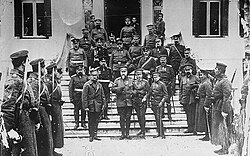
Back الأزمة الشرقية الكبرى Arabic Източна криза Bulgarian Velká východní krize Czech Balkankrise German Balkanin kriisi Finnish Grande Crise Orientale French Balkán-válság Hungarian Krisis Timur Besar ID Grande crisi d'Oriente Italian Голема источна криза Macedonian
| Great Eastern Crisis (1875–1878) | |||||||||
|---|---|---|---|---|---|---|---|---|---|
| Part of the rise of nationalism under the Ottoman Empire and of the Great Game | |||||||||
 Serbian soldiers attacking the Ottoman army at Mramor, 1877 | |||||||||
| |||||||||
| Belligerents | |||||||||
| Supported by: |
* Imamate rebels Abkhazian rebels Supported by: | ||||||||
| Commanders and leaders | |||||||||
| Strength | |||||||||
|
| ||||||||
| Casualties and losses | |||||||||
|
| |||||||||
| Events leading to World War I |
|---|
 |
|
The Great Eastern Crisis of 1875–1878 began in the Ottoman Empire's territories on the Balkan peninsula in 1875, with the outbreak of several uprisings and wars that resulted in the intervention of international powers, and was ended with the Treaty of Berlin in July 1878.
It is also called Serbo-Croatian: Velika istočna kriza; Turkish: Şark Buhranı ("Eastern Crisis", for the crisis in general), Turkish: Ramazan Kararnamesi ("Decree of Ramadan", for the sovereign default declared on 30 October 1875) and Turkish: 93 Harbi ("War of 93", for the wars on the Balkan peninsula between 1877 and 1878, referring in particular to the Russo-Turkish War, the year 1293 on the Islamic Rumi calendar corresponding to the year 1877 on the Gregorian calendar).
- ^ Timothy C. Dowling. Russia at War: From the Mongol Conquest to Afghanistan, Chechnya, and Beyond. ABC-CLIO, 2014. p. 748
- ^ Mernikov, A. G.; Spektor, A. A. (2005). Всемирная история войн [World History of Wars] (in Russian). Minsk, Belarus: Харвест.
- ^ Urlanis, Boris (1960). Войны в период домонополистического капитализма [Wars during the period of pre-monopoly capitalism]. Войны и народонаселение Европы. Людские потери вооруженных сил европейских стран в войнах XVII—XX вв. (Историко-статистическое исследование) [Wars and population of Europe: Human losses of the armed forces of European countries in the wars of the 17th—20th centuries (Historical and statistical research)] (in Russian). Minsk: Sotsekgiz. pp. 104–105, 129 § 4.
- ^ Scafes, Cornel, et al., Armata Romania in Razvoiul de Independenta 1877–1878 [The Romanian Army in the War of Independence 1877–1878]. Bucuresti, Editura Sigma, 2002, p. 149 (Romence)
- ^ a b Boris Urlanis, Войны и народонаселение Европы [Wars and population of Europe], Part II, Chapter II
- ^ a b Mernikov, A. G.; Spektor, A. A. (2005). Всемирная история войн [World History of Wars] (in Russian). Minsk, Belarus: Харвест. ISBN 985-13-2607-0.
© MMXXIII Rich X Search. We shall prevail. All rights reserved. Rich X Search